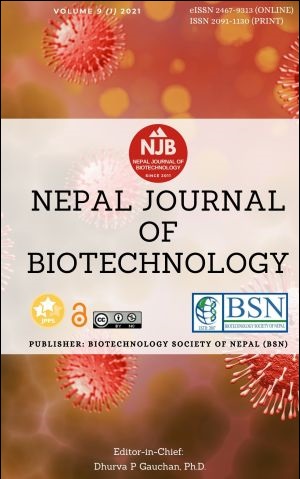Assessment of phytochemicals, antimicrobial, antioxidant and cytotoxicity activity of methanolic extract of Tinospora cordifolia (Gurjo)
DOI:
https://doi.org/10.3126/njb.v9i1.38646Keywords:
Tinospora cordifolia, Antioxidant activity, Antibacterial activity, Phytochemicals, DPPH, Brine Shrimp BioassayAbstract
Traditionally used medicinal plants are the major resources of biologically active metabolites which are widely used for the cure of numerous diseases especially in developing countries where health facilities are rare. Many plants are in use for centuries but there is not enough scientific evidence and exploration. This research is focused on phytochemicals, antibacterial, antioxidant and cytotoxicity activity analysis of one of the most commonly used ethnomedicine Tinospora cordifolia collected from the Kavrepalanchok district of Nepal. Phytochemicals analysis of methanol extract of T. cordifolia showed the presence of alkaloids, coumarin saponins, glycosides, reducing sugar, and triterpenes. Antibacterial activity performed by disc diffusion method exhibited the highest activity against Streptococcus with a zone of inhibition are 10.3mm, 8.5mm, 6.5mm, and 6mm at 200mg/ml, 100mg/ml, 50mg/ml, and 25mg/ml of concentration respectively. DPPH radical scavenging activity increased with increasing concentration of extract. When compared with ascorbic acid at equivalent concentration, the extract shows a lower scavenging profile (56.07% for the extract and 98.01% for ascorbic acid at 320 ppm). Cytotoxicity was evaluated in terms of LC50 (lethality concentration). The result showed that the extract of T. cordifolia was found to be toxic with an LC50 value of 232.64μg/ml. The bioactive component present in the plants could be the result of its pharmacological effects that support the traditional use of plants.
Downloads
Downloads
Published
How to Cite
Issue
Section
License
Copyright (c) 2021 Biotechnology Society of Nepal

This work is licensed under a Creative Commons Attribution-NonCommercial 4.0 International License.
Copyright Notice:
The manuscript submitted to NJB must be an original contribution, not previously published and should not be under consideration for publication elsewhere. When the manuscript is accepted for publication, the authors agree to automatically transfer the copyright of the article to the publisher. It should grant permission to any third party, in advance and in perpetuity, the right to use, reproduce or disseminate your article, according to the NJB copyright and license agreement.
Authors transfer copyright to the publisher as part of a journal publishing agreement but have the rights to: Share their article for Personal Use, Internal Institutional Use and Scholarly Sharing purposes, with the NJB applies the Creative Commons Attribution-NonCommercial CC BY-NC license to all the works we publish after Jun 2020 (Before it was CC BY-NC-ND). Under this license, authors agree to make articles legally available for reuse, without permission or fees, for virtually any non-commercial purpose. Anyone may remix, adapt, and build upon your work non-commercially, and although their new works must also acknowledge you and be non-commercial, they don’t have to license their derivative works on the same terms. More details on CC BY-NC refer to its Licence Deed and Legal Code.






